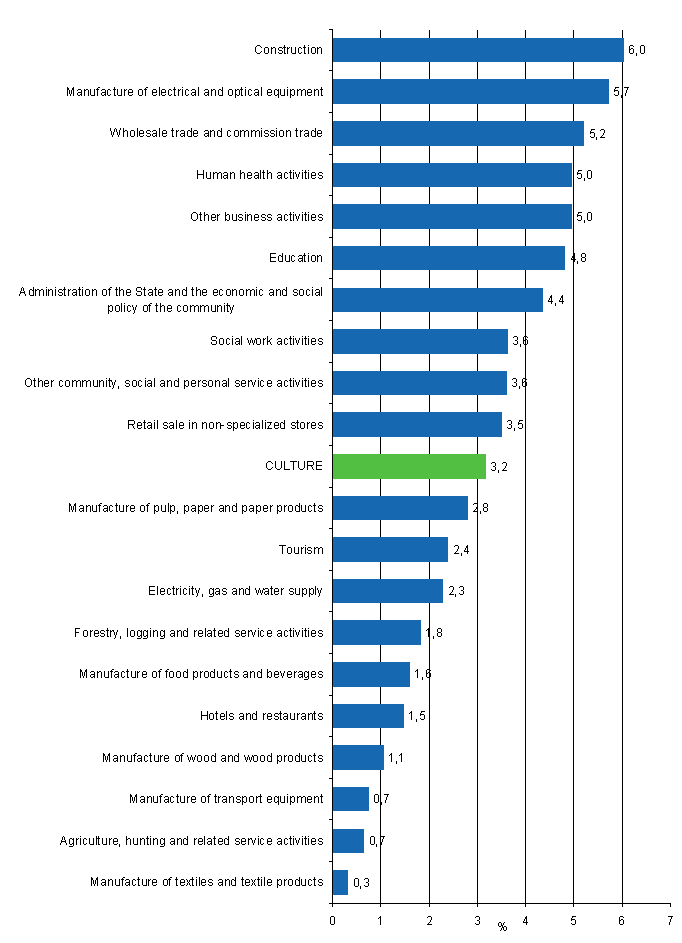Published: 5 March 2009
Fields of culture generated EUR 4.6 billion value added in 2006
According to national accounts data, fields of culture and mass media generated a good EUR 4.6 billion value added in Finland in 2006. This amounted to 3.2 per cent of GDP.
Value added generated by culture and the mass media was clearly higher in 2006 than that generated by traditional primary and secondary production industries, such as manufacture of wood and wood products, agriculture and hunting, forestry or the manufacture of pulp, paper and paper products. Culture also outpaced tourism and hotels and restaurants, but many other service industries were economically more significant and grew at a faster rate than culture. Culture itself extends to the fields of both manufacturing and service production.
International comparisons show that fields of culture are very important in Finland but the growth in culture's GDP share has moderated
According to the report on the economy of culture commissioned by the European Commission, the turnover of the field of culture was EUR 636 billion and its GDP share stood at 2.6 per cent in the EU25 countries in 2003. The report estimated the growth of this sector to be stronger than average. In Finland the economic significance of culture is among the highest in the EU. According to calculations based on national accounts data, growth of the GDP share of the field has, however, moderated in recent years. The share has stayed at the 3.1-3.3 per cent level in the 2000s, whereas in the late 1990s it ranged between 3.5 and 3.7 per cent (see appendix table Gross value added of culture by industry 1995-2006).
A sizable part of the value added of culture is generated by the field of the mass media. In 2006 the publishing and printing of newspapers and periodicals, news agencies as well as radio and television activities covered nearly one-third (32.7 per cent) of the value added generated by culture. If we also include books, films and other printing, the share of the mass media rises to clearly over one-half (53.5 per cent) of the value added generated by culture. The GDP share of the mass media, delimited as described above, was 1.7 per cent. The share of artist, stage and concert activities was 6.2 per cent of the value added generated by culture and 0.2 per cent of the value added of the whole national economy.
The respective weights of the different fields of culture have not changed radically since the mid-1990s. The share of the mass media has fallen from 60 to 53.5 per cent. By contrast, the shares of architecture and industrial design as well as advertising have grown slightly.
GDP shares of culture and certain comparison industries and industry groups in 2006

Calculation of the significance of culture in the national economy is being developed
A method for estimating the significance of culture in the national accounts framework is being developed in a joint project of the Ministry of Education and Statistics Finland. The report Culture satellite accounts (2008) published by the Ministry of Education includes the results of Statistics Finland's pilot calculation for the years 1995-2005. The examination concerned the share of cultural activities of GDP, employment, exports and imports of goods and services as well as domestic demand.
Development work on the calculation template of culture satellite accounts and the methods will continue in future. At present the data derived from it describe only the direct economic significance. In future the aim is to extend the calculation to cover also voluntary service provision which is widespread in the sector of culture. The estimation of cultural activities within manufacturing enterprises (such as industrial design) is also among the development aims. A calculation of cultural accounts by region for the years 2001-2007 is currently ongoing.
The data on the GDP share of culture in 2006 have been released as part of Statistics Finland's publication Cultural Statistics 2007. The biennial Cultural Statistics publication contains information about Finland's old and new minorities, languages, religions, cultural heritage, literature, theatre, music, cinema, visual art, crafts and design, cultural events and cultural centres, cultural education and labour force as well as cultural economy. The publication contains also international comparative statistics. The data derive from Statistics Finland and the Ministry of Education as well as institutions, organizations and enterprises operating in the field of culture. The publication contains 180 tables.
Source: Cultural Statistics 2007 (2009). Statistics Finland
Inquiries: Mr Jukka Ekholm, +358 9 1734 3370
(Cultural statistics)
Ms Sari Karttunen, +358 9 1734 2988 (Cultural statistics)
Ms Katri Soinne, +358 9 1734 2778 (National Accounts)
kulttuuri.tilastokeskus@stat.fi
Director in charge: Ms Riitta Harala
- Tables
-
Tables in databases
Pick the data you need into tables, view the data as graphs, or download the data for your use.
Last updated 5.3.2009
Official Statistics of Finland (OSF):
Culture [e-publication].
ISSN=2341-7404. 2007. Helsinki: Statistics Finland [referred: 19.4.2025].
Access method: http://stat.fi/til/klt/2007/klt_2007_2009-03-05_tie_001_en.html

